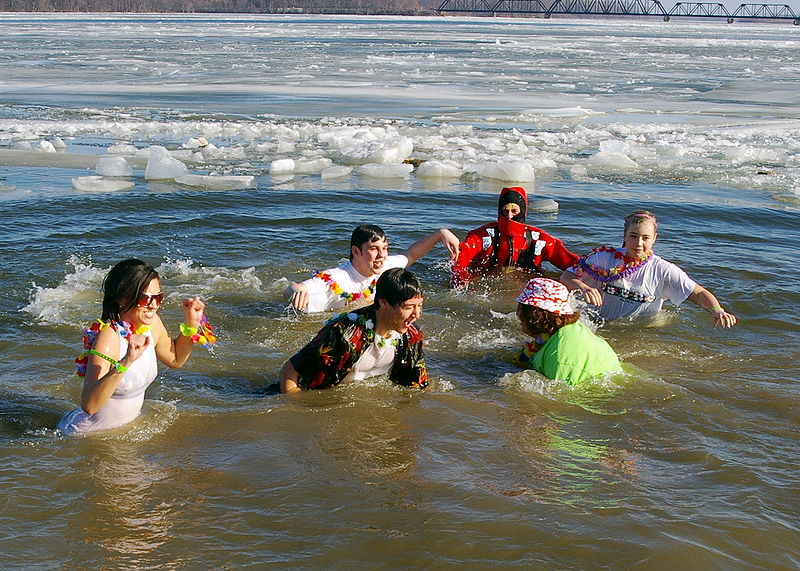11.2: Homeostasis
- Page ID
- 2956

How does your body react to cold?
These people may be having fun in the icy water, but their bodies are struggling to react to the cold. For example, they may begin to shiver. Shivering helps the body return to a stable temperature. The body is always working to achieve stability, or homeostasis.
Homeostasis and Feedback Regulation
When you walk outside on a cool day, does your body temperature drop? No, your body temperature stays stable at around 98.6 degrees Fahrenheit. Even when the temperature around you changes, your internal temperature stays the same.
This ability of the body to maintain a stable internal environment despite a changing environment is called homeostasis. Homeostasis doesn't just protect against temperature changes. Other aspects of your internal environment also stay stable. For example, your body closely regulates your fluid balance. You may have noticed that if you are slightly dehydrated, your urine is darker. That's because the urine is more concentrated and less water is mixed in with it.
Maintaining Homeostasis
So how does your body maintain homeostasis? The regulation of your internal environment is done primarily through negative feedback. Negative feedback is a response to a stimulus that keeps a variable close to a set value (Figure below). Essentially, it "shuts off" or "turns on" a system when it varies from a set value.
For example, your body has an internal thermostat. During a winter day, in your house a thermostat senses the temperature in a room and responds by turning on or off the heater. Your body acts in much the same way. When body temperature rises, receptors in the skin and the brain sense the temperature change. The temperature change triggers a command from the brain. This command can cause several responses. If you are too hot, the skin makes sweat and blood vessels near the skin surface dilate. This response helps decrease body temperature.
Another example of negative feedback has to do with blood glucose levels. When glucose (sugar) levels in the blood are too high, the pancreas secretes insulin to stimulate the absorption of glucose and the conversion of glucose into glycogen, which is stored in the liver. As blood glucose levels decrease, less insulin is produced. When glucose levels are too low, another hormone called glucagon is produced, which causes the liver to convert glycogen back to glucose.
For additional information, see Homeostasis at https://www.youtube.com/watch?v=rSBbnHLR_cg.

Positive Feedback
Some processes in the body are regulated by positive feedback. Positive feedback is when a response to an event increases the likelihood of the event to continue. An example of positive feedback is milk production in nursing mothers. As the baby drinks her mother's milk, the hormone prolactin, a chemical signal, is released. The more the baby suckles, the more prolactin is released, which causes more milk to be produced. Other examples of positive feedback include contractions during childbirth. When constrictions in the uterus push a baby into the birth canal, additional contractions occur.
Science Friday: Diary of A Snakebite Death
What does it feel like to be bitten by a venomous snake? In this video by Science Friday, learn about how Dr. Karl P. Schmidt wrote about the effects of snake bite venom while he was dying.
Summary
- Homeostasis is the ability of the body to maintain a stable internal environment despite a changing external environment.
- Homeostasis is maintained primarily through negative feedback, when a response to a stimulus keeps a variable close to a set value.
Explore More
Use the resources below to answer the questions that follow.
Explore More I
- Homeostasis at http://www.think-bank.com/iwb/flash/homeostasis.html
- List four internal conditions that humans regulate?
- What happens to blood flow in your body when your internal temperature increases?
- What happens to blood flow in your body when your internal temperature decreases?
- What is ADH? What is its function?
- What are the roles of insulin and glucagon? What do they help the body regulate?
Review
- What is homeostasis?
- What is the difference between negative feedback and positive feedback?
- What is a hormone?

